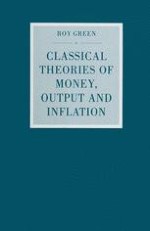1992 | OriginalPaper | Buchkapitel
Introduction of Paper Currency
verfasst von : Roy Green
Erschienen in: Classical Theories of Money, Output and Inflation
Verlag: Palgrave Macmillan UK
Enthalten in: Professional Book Archive
Aktivieren Sie unsere intelligente Suche, um passende Fachinhalte oder Patente zu finden.
Wählen Sie Textabschnitte aus um mit Künstlicher Intelligenz passenden Patente zu finden. powered by
Markieren Sie Textabschnitte, um KI-gestützt weitere passende Inhalte zu finden. powered by
After the ‘price revolution’ of the sixteenth and seventeenth centuries, the next major episodes of British monetary history had as their central focus the role of fiduciary money and credit. The first of these, the ‘bullion controversy’, took place as a result of the Napoleonic war inflation at the end of the eighteenth and beginning of the nineteenth centuries; and the second, the ‘currency-banking debate’, was motivated by the increasingly cyclical character of economic activity towards the middle of the nineteenth century. These disputes were no longer between a pure exchange quantity theory of money on the one hand and classical value theory on the other. The law of monetary circulation had by this time been firmly established. Monetary requirements were determined by the ‘supply side’ of the equation of exchange, i.e., by the level of output and prices. The questions now raised were whether in a credit or fiduciary system the money supply could exceed (or fall short of) the normal requirements, and, if so, how this excess (or deficiency) was to be measured and what would be the consequences. The answers to these questions implied specific sets of policies.
